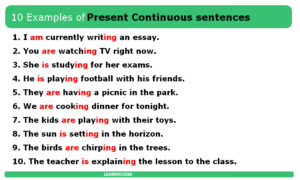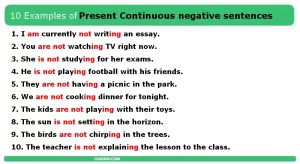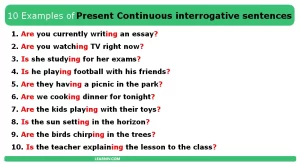There are several verbs that are not typically used in the present continuous tense (also known as the present progressive tense).
Some verbs are not typically used in the present continuous tense because they represent states, qualities, or non-action verbs. These verbs describe conditions or characteristics that are not usually associated with ongoing or temporary actions. Here are a few reasons why certain verbs are not commonly used in the present continuous tense:
Non-continuous (stative) verbs
These verbs describe states or conditions rather than actions and are not usually used in the present continuous (progressive). For example, we say “I understand” instead of “I am understanding.”
| Stative verb | Present Simple | Present Continuous |
|---|---|---|
| Believe | She believes his story. | She is believing his story. |
| Understand | They understand the task. | They are understanding the task. |
| Know | Do you know me? | Are you knowing me? |
| Love | She loves the new movie. | She is loving the new movie. |
| Hate | They hate this weather. | They are hating this weather. |
| Prefer | He prefers the blue one. | He is preferring the blue one. |
| Want | Do you want a cup of coffee? | Are they wanting a cup of coffee? |
| Need | She needs any assistance. | She is needing any assistance. |
| Belong | It does not belong to him. | It is not belonging to him. |
| Feel | She does not feel well today. | She is not feeling well today. |
Please note that while some of these verbs can have continuous (progressive) forms in specific contexts, in their general usage, they are more commonly used as non-continuous verbs.
Verbs of perception
Verbs that involve perception or senses are not commonly used in the present continuous because they are generally not ongoing actions. For example, we say “I see a bird” instead of “I am seeing a bird.”
| Verb of Perception | Present Simple | Present Continuous |
|---|---|---|
| see | I see a bird in the sky. | I am seeing a movie at the theater. |
| hear | I hear a beautiful song. | I am hearing a loud noise outside. |
| smell | It smells delicious in here. | It is smelling like fresh flowers. |
| taste | The soup tastes salty. | The food is tasting amazing. |
| feel | She feels cold in the winter. | I am feeling tired after a long day. |
Note: While the verbs of perception can be used in the present continuous (progressive) tense to describe ongoing or temporary sensations, they are more commonly used in the present simple tense to express general or habitual perceptions. The present continuous is typically used when the action or sensation is happening at the time of speaking.
Verbs of thinking
Verbs that describe mental activities or thoughts are not typically used in the present continuous. For example, we say “I think you’re right” instead of “I am thinking you’re right.”
| Verb of Thinking | Present Simple | Present Continuous |
|---|---|---|
| think | I think it’s a good idea. | I am thinking about my future plans. |
| believe | She believes in ghosts. | She is believing in herself. |
| consider | They consider him a good candidate. | They are considering their options. |
| suppose | I suppose you’re right. | I am supposing that it will rain later. |
| imagine | He imagines a world without war. | He is imagining himself on a beach. |
Note: While verbs of thinking can be used in the present continuous (progressive) tense to describe ongoing thoughts or contemplation, they are more commonly used in the present simple tense to express general thoughts, beliefs, or opinions. The present continuous is typically used when the thinking process is happening at the time of speaking.
Verbs of possession
Verbs that indicate ownership or possession are not commonly used in the present continuous. For example, we say “I have a car” instead of “I am having a car.”
| Verb of Possession | Present Simple | Present Continuous |
|---|---|---|
| have | I have a cat. | I am having dinner with friends. |
| own | They own a beautiful house. | They are owning a new business. |
| possess | She possesses great talent. | She is possessing a calm demeanor. |
| hold | He holds a key to the door. | He is holding a meeting in his office. |
| belong | These books belong to me. | These books are belonging to the library. |
Note: While verbs of possession can be used in the present continuous tense to describe temporary possession or actions related to possession, they are more commonly used in the present simple tense to express permanent or general possession. The present continuous is typically used when there is an ongoing action or temporary possession happening at the time of speaking.
TIP: 100 verbs in the present continuous tense
Verbs of feeling and emotion
Verbs that describe emotions or feelings are generally not used in the present continuous. For example, we say “I love chocolate” instead of “I am loving chocolate.”
| Verb of Feeling/Emotion | Present Simple | Present Continuous |
|---|---|---|
| feel | I feel happy. | I am feeling excited about the upcoming trip. |
| love | They love ice cream. | They are loving the beautiful weather today. |
| hate | She hates spiders. | She is hating the long wait at the airport. |
| enjoy | We enjoy playing music. | We are enjoying the concert right now. |
| like | He likes to read books. | He is liking the new TV series. |
Note: Verbs of feeling and emotion are typically used in the present simple tense to express general states or opinions. The present continuous tense is less common with these verbs and is usually used to describe temporary or ongoing feelings or emotions happening at the time of speaking.
TIP: Present Continuous Tense Examples
Typically used verbs in the Present Continuous tense
In English, the Present Continuous tense (also known as the Present Progressive tense) is commonly used with verbs that describe actions or activities happening at the time of speaking. Here are some examples of verbs that are typically used in the Present Continuous tense:
- Verbs of action: run, walk, eat, drink, dance, swim, play, write, speak, work, read, etc.
- Example: I am running in the park.
- Verbs of temporary states or conditions: feel, look, seem, smell, taste.
- Example: She is feeling tired today.
- Verbs of change or progression: grow, develop, improve, get, become, change, etc.
- Example: The flowers are growing in the garden.
- Verbs of communication: talk, speak, say, tell, discuss, chat, etc.
- Example: They are talking on the phone.
- Verbs of perception: see, hear, listen, watch, notice, observe, etc.
- Example: He is watching a movie.
- Verbs of movement: go, come, arrive, leave, travel, fly, walk, etc.
- Example: We are going to the beach.
It’s important to note that while these verbs are typically used in the Present Continuous tense, they can also be used in other tenses depending on the context and intended meaning.
More examples of Present Continuous sentences
- Sentences of present continuous tense
- 100 sentences of present continuous tense
- 50 sentences of present continuous tense
- 30 sentences of present continuous tense
- 20 sentences of present continuous tense
- 10 sentences of present continuous tense


